
Treating Burns Page Selection Menu: 1 2 3 4 5 6 7 8 9 10 Next>>
Treating Burns During the Golden Age of Piracy, Page 8
Burn Treatment - Medicines: Oils
Like many of the other treatments in this section, oils have a long history of being used to treat burns. Some
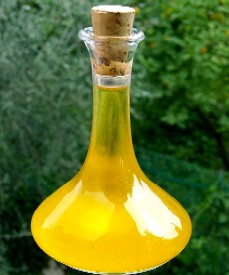
Photo: Wiki user Lemone
period medical authors recommended plain oil mixed with various substances be slathered on burns. Sea-surgeon John Woodall advised "beginning
thy worke [on burns] with Lotions, (as namely either a fomentation made with oyle and water...)"1
Stephen Bradwell suggested that the home healer beat egg whites with "sallet oyle. Dip fine rags in it, and apply them to the place, and take them off no more till it be well. Onely three or foure times in a day wet the place through them with the sayd mixture."2
Sea-surgeon John Moyle noted that he sometimes used a Balsamick mixture containing regular and concentrated oils, "which indeed is excellent in all Wounds, whether in Carnous or Nervous parts,
whether by Gun-shot, or Burning, or Scalding. 'Tis this.
Rx. Linimentum arcei [a mild stimulating liniment for healing of ulcers – made from elemi resin, turpentine, suet and olive oil] {8 ounces}, Ol. Hyperic. Comp. [St. John's wort] (2 ounces} , Ol. Cera [Oil of Wax] {half ounce} misce f. Balsam. [mixed into an oily resin]"3.
Regular oils weren't used nearly as often during the golden age of piracy as concentrated oils. Such oils are sometimes referred to as 'essential oils' or 'volatile oils'.4 These are usually derived from plants through the process of distillation, with some exceptions.5 Let's look at some of the more commonly prescribed 'essential' oils used on burns by period medical writers.
1 John Woodall, the surgions mate, p. 146; 2 Stephen Bradwell, Helps For Suddain Accidents Endangering Life, p.120; 3 John Moyle, The Sea Chirurgeon, p. 13-4; 4 See any period pharmacopeia for examples such as Nicholas Culpeper's Pharmacopœia Londinesis or James Rennie's A New Supplement to the Pharmacopœpias of London, Edinburgh, Dublin and Paris, Baldwin and Cradock; 5 One fascinating exception to distillation for a burn-prescribed oil is Egg Oil. In his book A Supplement to the Pharmacopoeia: Being a Treatise on Pharmacology in General, Samuel Gray gives a recipe for the production of Egg Oil. "Obtained by boiling eggs, so that the yolks may be hard, separating the whites, roasting the yelks, first broken in two or three pieces each, in a frying pan over the fire till the oil begins to exude out of them, and then pressing them with great force; very emollient; fifty eggs yield about five oz. of oil. Old eggs yield the greatest quantity." (p. 227)
Oil of Elders
Oil of elders aka. Oleum Sambucus, is obtained from boiling the flowers of the elderberry (Sambucus) tree in olive oil,

Photo: Kurt Stüber - Black Elder Flowers
"till the flowers are crisp, when the whole is to be pressed, and put aside to clear."1 This was considered a cooling remedy (as were most oils from a humoral perspective).
Curiously, this 'cooling' oil has roots in cauterization. Ambroise Paré notes that early 15th/16th century Italian surgeon John [Giovanni] de Vigo believed that Gunshot wounds were "poisoned, and that by reason of the Gunpowder; Wherefore for their cure, it was expedient to burn or cauterize them with oil of Elders scalding hot, with a little Treacle mixed therewith."2 Paré didn't credit de Vigo's assertion, following an experiment he (accidentally) made that showed him it was not true. (See the Gunshot wounds article for more on that.)
Military surgeon Raymund Minderer recommends this remedy for burns in several places in his book. For example, he advised the reader to "take Oyl of Elder, or stale Oyl that hath been long in a burning Lamp, beat half as much, as you take of that, of the Whites of Eggs amongst it, and anoint the burnt part therewith."3 While he appears to rate Oil of Elders highly, he also suggested "[i]f you can get no Oyl of Elder, take any other cooling Oyl, as of Nympaea, (Water-lillies) Poppyseeds, Violets or Roses, or the Oyl of Poplar-buds, or of Marsh-Marigold Flowers."4
In a similar way, naval surgeon John Atkins advises that a surgeon at sea take thin linnen "dipped in any emollient Oyls, Ol. Sambuc. [oil of elders] Lini. [linseed oil] Amygdal. [oil of bitter almonds] Olivar. [olive oil] &c."5
1 James Rennie's A New Supplement to the Pharmacopœpias of London, Edinburgh, Dublin and Paris, Baldwin and Cradock, p. 272; 2 Ambroise Paré, The Workes of that Famous Chirurgion Ambrose Parey, p. 309; 3 Raymund Minderer, A Body of Military Medicines Experimented, Volume 4 of Paul Barbette's, Thesaurus Chirurgiæ, The Fourth Edition, p. 110; 4 Minderer, ibid.; 5 John Atkins, The Navy Surgeon, p. 176
Linseed or Flaxseed Oil
Linseed

Photo: Wiki user Handwerker - Linseed - Seeds, Oil & Flax Seed Cakes
or flaxseed oil, is obtained "by expression
from bruised flax-seed."1 James Rennie notes that it "has almost the same properties as
olive oil, but is nauseous and of a disagreeable odour. It soon also becomes rancid."2 This would seem to make it an unlikely ingredient for shipboard use where longer-lasting substances were generally preferred.
Still, linseed oil has a long pedigree in burn treatment. Military surgeon William Clowes recommended it in his book on gunshot wounds in the late 16th century.3 Another military surgeon from the golden age of piracy, Raymund Minderer suggests its use, mixing it with cream4, egg yolk5 and varnish6 in different places in his comments on treating burns.
Robert Boyle advises it in his "easie and approved Remedy for Burns, especially Recent ones." He suggests using "a sufficient quantity of Adders-Tongue [Ophioglossum], and boil it softly in Linseed-Oyl till the Liquor be strongly impregnated with the Herb, then strain it, and keep it stopt for use."7
1 James Rennie's A New Supplement to the Pharmacopœpias of London, Edinburgh, Dublin and Paris, Baldwin and Cradock, p. 282; 2 Rennie, ibid.; 3 William Clowes, A Profitable and Necessarie Booke of Observations, for all those that are burned with the flam of Gun powder &c., p. 8; 4 Raymund Minderer, A Body of Military Medicines Experimented, Volume 4 of Paul Barbette's, Thesaurus Chirurgiæ, The Fourth Edition, p. 110; 5 Minderer, p. 111; 6 Minderer, ibid.; 7 Robert Boyle, Mr. Boyle's Receipts, Vol. II., p. 62
Oil of Roses
Oil of roses
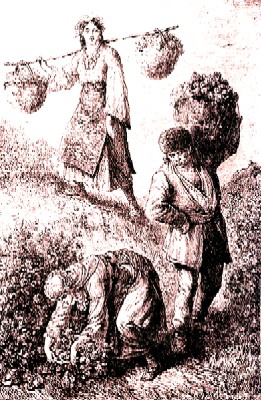
Artist: Felix Phillipp Kantz
Picking Damask Roses - Kazanlak, Bulgaria
was a popular ingredient in period medicines and has the widest support of any oil in the literature from that period for treating burns. To make it, Nicholas Culpeper recommended the use of "Roses fully open, bruised, set in the Sun and boiled gently [with an oil like olive oil] in a double vessel, only let the third Infusion stand in the Sun 40 days, then keep the Roses and oil together."1
Like linseed oil, William Clowes recommended the use of rose oil in combination with other herbs when treating burns. He advised this in several places in his dicussion on burn treatment.2 Raymund Minderer suggests its use with purified quicklime ointment (Calx. viva.) to create an ointment for burn treatment.3
Sea-surgeon John Woodall adds it to a concoction used for suppuration [pus formation] "mixt with the white of an egge"4. (Rose oil was clearly durable enough to survive the long shipboard voyages.)
Fellow sea surgeon John Atkins recommends that "Applications [begin] immediately at receiving the Hurt ...anointing the Parts well with a Mixture of Ol. Rosar & Aq. Calcis ana part æqualies. [oil of roses and lime water in equal parts]"5
John Moyle gives us a trifecta of sea-surgeons recommending rose oil as he details a way to remove the pain and the burning sensation from a wound site. "You are first to anoint all over where the Burn is with this following. Rx. Alb. ova. Contund. Ol. Rosar., misce. [white ointment mixed with oil of roses] Let the part be anointed all over well with this mixture on a Feather, and dip a fine Cloth in the same and apply it."23
1 Nicholas Culpeper, Pharmacopœia Londinesis, p. 214; 2 William Clowes, A Profitable and Necessarie Booke of Observations, for all those that are burned with the flam of Gun powder &c., p. 3-8; 3 Raymund Minderer, A Body of Military Medicines Experimented, Volume 4 of Paul Barbette's, Thesaurus Chirurgiæ, The Fourth Edition, p. 111; 4 John Woodall, the surgions mate, p. 145; 5 John Atkins, The Navy Surgeon, p. 176; 6 John Moyle, The Sea Chirurgeon, p. 97-8
The Modern Take on Essential Oils in Burns

Artist: Lucas Jennis - Distilling from Tripus Aureus (1618)
Essential oils are still believed to have burn healing properties according to homeopathic websites. experience-essential-oils.com explains, "All types of burns will benefit from using essential oils. And you can use them for cleaning burns, managing pain, combating infection and to prevent sunburn."1 This website lists several essential oils for this purpose, none of which were mentioned here.
Former sea surgeon Vice-Admiral Sir James Watt wrote in 1985 that linseed and rose oils "provided a protective coagulum, vitamins which assisted healing and pain-killing salicylates."2 However, paramedic Ron Brouhard recommends never using oils on burns on about.com, noting that "oils will trap heat and make the burn deeper over time."3 Who is right can only be proven with scientific analysis which does not appear to have been made yet.
1 Burn Home Remedies Easily Made with Essential Oils!, experience-essential-oils.com, gathered from the internet on 7/6/13; 2 Vice-Admiral Sir James Watt, "Some forgotten contributions of naval surgeons", Journal of the Royal Society of Medicine, Vol. 78, September 1985, p. 755; 3 Ron Brouhard, How To Treat a Burn, about.com, gathered from the internet on 7/6/13
Burn Treatment - Medicines: Onions
Onions also have an extensive pedigree as a burn curative. In the medical literature, which began with Ambroise Paré, who had heard of onions as a folk remedy for burns and decided to test it out for himself.
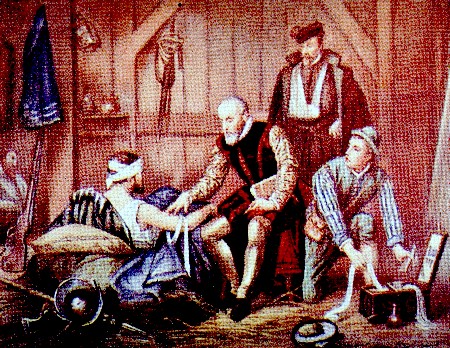
Artist: E. Hamman - Pare Bandaging the Wounded
One of the Marshall of Montejan his Kitchin boyes, fell by chance into a Caldron of Oyle being even almost boyling hot; I being called to dresse him, went to the next Apothecaries to fetch refrigerating medicines commonly used in this case: there was present by chance a certaine old countrey woman, who hearing that I desired medicines for a burne, perswaded mee at the first dressing, that I should lay to raw Onions beaten with a little salt; for so I should hinder the breaking out of blisters or pustules, as shee had found by certaine and frequent experience. Wherefore I thought good to try the force of her Medicine upon this greasy scullion. I the next day found those places of his body whereto the Onions lay, to be free from blisters, but the other parts which they had not touched, to be all blistered.1
Many golden age of piracy period authors recommended onions be used on burns. Herbalist Nicholas Culpeper explained that, "Raw they take the fire out of Burnings"2. Similarly, Robert Boyle, possibly drawing on Paré's comments, suggests that when treating burns, the reader should "Take Onions, and beat them into a soft Mass, and apply
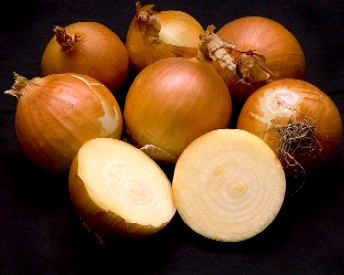
them as speedily as you can to the Part affected, and keep them on it, till they begin to grow dryish, and then if need be, shift them, and apply fresh ones."3
When treating recent burns, Boyle gives similar advice with an addition. "Take Onions a sufficient quantity, and beat them very well with common Salt finely powdered into a Mash, that may be applied as a Cataplasm [poultice] (the Cold being first taken off) to a part affected, and renewing it, if need be, till the impression of the Fire be taken out."4
Indeed, salt and onions seems to be the magic combination. Even august military surgeon Richard Wiseman admits that "the common remedy is to apply Salt and an Onion beaten together."5 William Fabry suggests it's best to take "Onions being mixed in morter with a little Salt and applied to the burnt place, doth draw forth the corrupt humours, and suffereth not the pustels [blisters] to arise, it may be spread on little pleggets and applyed, untill the whole burnt place bee covered."6
However, Fabry also warns that when burns "do penetrate more deep, so
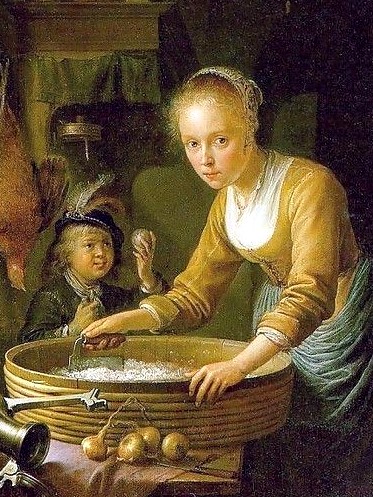
Artist: Gerrit Dou - Girl Chopping Onions (1646)
that not only pustels or blisters are raised, but that also the skin be burnt dead and contracted, then neither Onions, sope, salt, neither any kinde of Medicines are to be applied, much lesse those which are before said to be cold and dry"7.
In a similar manner, Wiseman advises the surgeon not to apply onions "after the Blisters are risen, nor by any means where the Pain is raw; for so you will exasperate the Pain, and increase the Inflammation."8
How do onions stack up from a modern perspective? Surprisingly well. All the herbal and natural medicinal sites gush about their usefulness in treating burns. A blog on ifood.tv proclaims the many benefits of onions in burns in fine bullet-point format:
- Onions help to soothe scalds and minor burns, keep away the air, and relieve pain.
- A freshly cut onion when topically applied on to a burn wound helps alleviate the sting almost immediately, offering you instant relief from the burning pain.
... - You can also use onion juice to visibly reduce burn scars. As onions help to inhibit the progress of collagen that causes scar growth, it can play a pivotal role in eliminating burn marks.
- Being a natural antiseptic, onions help to thwart all risks of infections in the wound. Also, since it contains sedative properties, it helps to calm the irritated skin in and around the wounded area and promote quick recovery.9
There are few detractors to the use of onions in lesser burns. Sir James Watt points out that onion juice combined with saline contains "vitamins A, B, C and D and essential oils and enzymes" and suggests they would be most useful in treating superficial burns."10
1 Ambroise Paré, The Apologie and Treatise of Ambroise Paré, p. 140; 2 Nicholas Culpeper, Pharmacopœia Londinesis, p. 4; 3 Robert Boyle, Mr. Boyle's Receipts, Vol. II., p. 61; 4 Boyle, ibid.; 5 Richard Wiseman, Eight Chirurgicall Treatises, 3rd Edition, p. 430; 6 Guliielm. Fabritius Hildanus aka William Fabry, His Experiments in Chyrurgerie, p. 20-1; 7 Hildanus, p. 27; 8 Wiseman, ibid.; 9 Blogger Gourmet_lover, Onion For Burns — Good Or Bad, ifood.tv, posted September 12, 2011, gathered from the internet 7/6/13; 10 Vice-Admiral Sir James Watt, "Some forgotten contributions of naval surgeons", Journal of the Royal Society of Medicine, Vol. 78, September 1985, p. 755Burn Treatment - Medicines: Quinces
Quinces are

Artist: Franz Eugen Koehler -
A Diagram of the Quince Fruit (1897)
an unusual remedy for burns from our modern perspective. They do have a long history of being used as a medicine, although they are primarily swallowed rather than applied topically.1 Still, a couple of the period authors do suggest them.
Raymund Minderer recommends a rather interesting quince-based remedy. "If you can have Quince-wine, it marvelously extinguishes the burning of any [gun]shot, dipping a Linnen pledget in it, and drawing it through the wound, or left in it, repeating this every twelfth hour. The Juyce or Wine of Quinces must be used as it comes from the fruit, without any mixture of Sugar. This I learn'd from a Nobleman, a
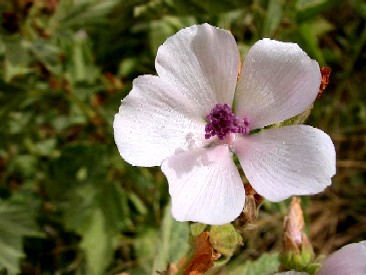
Photo: Pablo Alberto Salguero Quiles - Marsh Mallow Flower
great Souldier, of long experience in the Wars of France, the Low-Countries and Hungary."2 The alcoholic content of the wine would indeed have an astringent or cleansing quality. In addition, the coolness of the liquid would also serve in the same capacity as cold water.
Sea surgeon John Woodall suggests something that sounds a bit more medicinal in nature. He recommends a lotion such as a "decoction of the seedes of Quinces, or of Mallowes, March-mallowes, Violets, and a little Pursaline seede these and the like take away all the powder that sticketh in the flesh, for it hindereth the cure."3 Woodall has a tendency to offer many different, yet similar, medicines in his remedies. This may be in part because he wasn't sure what would work, but may also have been for the benefit of the sea surgeon's mates who would have to use whatever ingredients they had at hand.
1 Quince, wikipedia, gathered from the internet on 7/6/13; 2 Raymund Minderer, A Body of Military Medicines Experimented, Volume 4 of Paul Barbette's, Thesaurus Chirurgiæ, The Fourth Edition, p. 111; 3 John Woodall, the surgions mate, p. 145
Burn Treatment - Medicines: Rose Water
Rose water

Artist: Francisco de Zurbarán
was another rose-based cure for burns, although much more diluted in nature than rose oil. It is distilled from Damask roses and is "aromatic, and feebly astringent [contract's the body's tissues]. Chiefly
used as a vehicle for other substances."1
Rose water is indeed often found in combination with other medicinals. John Woodall commends it to his readers in a recipe consisting of "the fat of rustie bacon washed in Rose-water, or the like."2 (What 'rusty' bacon might be is not entirely clear - it may refer to the alternate red and white coloring.)
In the section on Butter-based medicines, you may recall that Stephen Bradwell's prescription 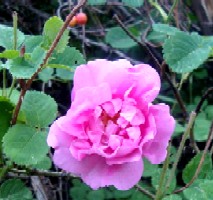
Photo: Javad Yousefi
A Damask Rose
for butter and goose dung was to be washed seven times in spring water with the coup d'grace being an eighth washing in rose water (for the smell, no doubt).3 In a medicinal creation for facial burns, William Fabry advises the application of a rose-oil based prescription to which is added "a little quantitie of the Musilage of Cydon seeds [quince seeds] extracted with Rose-water"4.
As can be seen, rose-water is never the primary ingredient in any of these prescriptions for burns, but it is frequently used with other medicines, quite possibly for its scent as for any healing capabilities it may have.. It would also be a pleasant way to cool a burn given the scent, but no period author recommends it be used in this manner.
1 James Rennie, A New Supplement to the Pharmacopœpias of London, Edinburgh, Dublin and Paris, Baldwin and Cradock, p. 33; 2 John Woodall, the surgions mate, p. 146; 3 Stephen Bradwell, Helps For Suddain Accidents Endangering Life, p.124; 4 Guliielm. Fabritius Hildanus aka William Fabry, His Experiments in Chyrurgerie, p. 24
Burn Treatment - Medicines: Saccharum Saturni
Saccharum Saturni
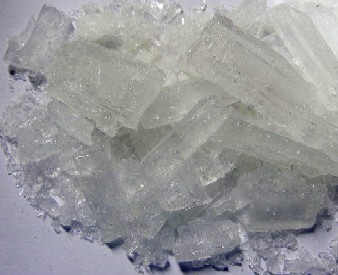
Photo: Wiki user dormroomchemist
Lead Acetate aka. Sugar of Lead
aka. Saccharum Saturni
(aka. Sugar of Lead or Plumbi Acetas or Acetate of Lead) is made by boiling white lead in a combination of distilled water and acetic acid and filtering the results. James Rennie explains the origin of the common name, noting that "it looks like lumps of sugar...and [is] of a sweet and astringent taste."1 He goes on to explain that when it is applied topically, "it is a most valuable application as a cooling sedative, and astringent"2, both of which qualities which would be useful when applied to a burn. However, Rennie also warns that "it is scarcely safe when the skin is abraded [open]"3, making it directly applicable only in lesser burns during this period.
Robert Boyle suggests using it to create and "Excellent Oyntment for Burns and Scaldings."4 His prescription is to combine half a dram of it with "the sharpest Vinegar four Ounces, make a Solution of the former in the latter, and add to this Solution drop by drop (often stirring or shaking them together) as much Oyl of Elder as will serve to reduce the Mixture into the form of a Nutritum or Oyntment."5 Boyle doesn't appear concerned about applying it to open wounds because he gives no such warnings.

Sea-surgeon John Moyle
John Moyle details its use in a case study he presented on a man who had burned the side of his face.
I was sent for unto him, and immediately I snipt the Vesculæ [blisters], and let out the scalding Humor, then used this; Rx. Crem. Lactis [milk cream] {half pound} Aq. plantag. [plantago/plantain water] {4 ounces} Alb. unius Ovi. [one egg white] Sacchar. Saturni {10 grains} misce. {mixed} with this I stuped the Ambustion [wet the burn] all over, as also a good bredth of the parts about it, to prevent more humours falling to it, and to ease the intolerable inflammation; then to the weeping ulcerations where the Epidermis was excoriated [damaged], I applied small Linteolas [small pieces of linen cloth] armed with the following Rx. Ungt. Rosat. [rose unguent] {4 ounces} Ol. Myrtil [oil of myrtle berries] {1 ounce} Sacchar Saturn {15 grains} misce. I spread of the same on a large Sindon [medicated linen rag], and applied it smoothly over all, only the places burnt to Escars.6
There are no modern comments on the effectiveness of such a substance because even the most die-hard naturalists wouldn't suggest the application of a lead-based medicine to the human body.
1 James Rennie, A New Supplement to the Pharmacopœpias of London, Edinburgh, Dublin and Paris, Baldwin and Cradock, p. 331; 2 Rennie, p. 332; 3 Rennie, ibid.; 4 Robert Boyle, Mr. Boyle's Receipts, Vol. II., p. 62; 5 Boyle, ibid.; 6 John Moyle, Memoirs: Of many Extraordinary Cures, p. 115-6

